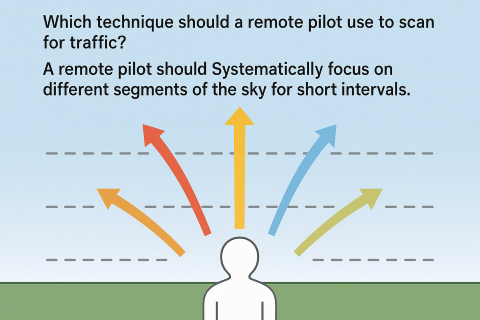FAAWhich technique should a remote pilot use to scan for traffic? A remote pilot should
- ✅A:Systematically focus on different segments of the sky for short intervals.
- ❌B:Concentrate on relative movement detected in the peripheral vision area.
- ❌C:Continuously scan the sky from right to left.
Answer Figure

Click to enlarge answer figure
Explanations
- A: Correct. Systematically focusing on different segments of the sky for short intervals is the most effective method for scanning for traffic. This technique reduces eye fatigue and increases the likelihood of detecting conflicting traffic. For a commercial drone operation, this method ensures safety and reduces the risk of collision, damage, and injury, thus avoiding potential regulatory fines and preserving business reputation.
- B: Incorrect. Concentrating on relative movement detected in the peripheral vision area is not a reliable method. While peripheral vision can detect motion, it may not be able to accurately identify static or slow-moving objects, which could pose a risk to the operation. In a business context, missing such objects could lead to accidents, damaging the drone, causing potential injury, and negatively affecting the business operation.
- C: Incorrect. Continuously scanning the sky from right to left is not an effective method. This approach can lead to motion blur and a lack of focused attention, which can cause the operator to miss potential hazards. In a commercial operation, this could lead to accidents, potential regulatory violations, and negative business impacts.
🧭 Instructor Note
Why This Matters for Your Business
Effective visual scanning techniques are crucial for safe and efficient drone operations. Systematically focusing on different segments of the sky for short intervals can help detect conflicting traffic, reduce the risk of collision, and maintain the integrity of your operation. This not only ensures safety but also preserves your business reputation and client trust.
Safety & Liability Considerations
Proper scanning techniques are essential for avoiding collisions, which can lead to damage, injury, and potential legal and regulatory consequences. Ensuring safety in your operations can also reduce insurance costs and potential liability claims.
Consider This Scenario
In the real estate industry, a drone operator is hired to capture aerial footage of a large property. The operator uses systematic scanning to monitor the sky for other aircraft. This technique allows the operator to detect a manned helicopter flying at a low altitude in time to safely land the drone and avoid a potential collision. The operator's effective scanning technique not only ensured safety but also preserved the drone and the footage, allowing the project to be completed successfully.
What the FAA is Testing
The FAA is testing your understanding of effective visual scanning techniques for detecting traffic. This is a critical skill for maintaining safety and complying with FAA regulations.
Business Success Strategy
Implement systematic scanning techniques in your operations and train your operators to do the same. This will not only improve safety but also increase operational efficiency. Remember, a well-scanned sky is a safe sky.
Memory Aid
As a driver, you don't just stare out front, you check mirrors, out the sides. As a pilot, risks come from all directions.
Enhanced References
FAA Aeronautical Information Manual (AIM), Chapter 4, Section 3: "Air Traffic Control and General Operations", Subsection 2: "Visual Scanning"
Related Concepts
- Visual Scanning Techniques
- See-and-Avoid Principle
- Collision Avoidance
ACS Code: UA.I.B.K14a
Difficulty: basic
